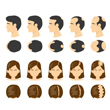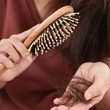How to Use Minoxidil?
How to Use Minoxidil for Hair Regrowth
Introduction 1
Millions of people worldwide experience hair loss in one form or the other at some point in their life. Given the prevalence of hair loss issues, many treatments for the same are also gaining popularity. Minoxidil is one such option that has shown promising results in treating Androgenetic Alopecia (AGA) in both men and women.
In women, female pattern hair loss (FPHL) often begins in their 40s and 50s though some may experience it earlier. Dermatologists often prescribe minoxidil for treating FPHL. The sooner you start your treatment, the higher the chances of preventing further hair loss due to AGA and boosting hair regrowth.

Is Minoxidil Really Effective? 2
Minoxidil is a medication approved by the CDSCO as a treatment for Androgenetic Alopecia (AGA) in both men and women. In India, it is a prescription-only medication and is available in the form of foam and solutions for topical application. Minoxidil is a vasodilator and an antiandrogen that works through multiple pathways to prevent hair loss and promote regrowth. It also has anti-inflammatory properties and may affect the length of the anagen and telogen phases of the hair growth cycle.
Regular topical application of minoxidil over a period of time is likely to result in hair regrowth in both frontotemporal and vertex areas. It is important to note that one must continue the treatment consistently for at least 3-4 months to see visible results.
How to Use Minoxidil?
Minoxidil is an effective treatment for combating AGA in both men and women. To enjoy the best results, it is vital to use minoxidil correctly. Follow these steps to ensure that you derive the maximum benefit out of your minoxidil treatment.
- Minoxidil should be used on a clean and dry scalp. Ensure that your scalp and hair are dry before you proceed with the treatment.
- Part your hair into rows and sections to properly expose the areas where your hair is thinning.
- When using minoxidil solution, use an applicator to apply the prescribed amount of liquid to your scalp. Follow your dermatologist’s instructions on how to apply the solution properly.
- Wash your hands with water and soap immediately after using this medication.
- Do not wash or shampoo your hair for at least 4-5 hours after the topical application of minoxidil.
- Do not use a hairdryer or any styling tool on your hair immediately after using minoxidil. Let your scalp and hair dry naturally.
- Let your scalp and hair dry completely before going to bed, as the minoxidil solution can stain your pillow cover.
The dosage prescribed for each patient will be different depending upon several factors. Strictly adhere to the dosage prescribed to you by your dermatologist, and don’t exceed it.

Tips for Using Minoxidil
Minoxidil is a very potent medication, and it can give you great results if used regularly and as prescribed by your dermatologist. Here are a few easy tips to make your minoxidil treatment more effective:
- Minoxidil should not be used anywhere else on the body except your scalp.
- Do not double the dosage to make up for any missed doses.
- Do not use minoxidil 24 hours before and after hair treatment procedures like dyeing or re-bonding
- Store your minoxidil solution at room temperature, away from extreme heat or cold.
- Do not use minoxidil if your scalp has any open wounds or sores.
Debunking Myths on Minoxidil 3, 4
Minoxidil is a very effective and popular medication for treating AGA. However, there is a lot of misinformation floating around about this treatment. Here we debunk a few of them:
- Myth 1: Minoxidil can’t be used by women.Fact: Minoxidil is an effective treatment for AGA in women.
- Myth 2: Minoxidil can reverse baldness.Fact: While minoxidil is a good treatment for tackling hair loss due to AGA, it can’t reverse complete baldness.
- Myth 3: Minoxidil has no side effects.Fact: Minoxidil may have a few minor side effects like irritation, dryness, flaking, etc.
- Myth 4: Minoxidil is an over-the-counter medication.Fact: In India, you need a medical practitioner's prescription to buy minoxidil products.
- Myth 5: Minoxidil causes hair loss.Fact: In the initial few weeks, there might be some excess shedding as your hair cycle takes some time to adjust to the new medication. However, with time, you will start to notice new hair growth.
In Closing Thoughts
Dermatologists across the world prescribe minoxidil for treating AGA in men and women. If your dermatologist has prescribed minoxidil, ensure that you use it the right way to reap the maximum benefit. Follow their instructions regarding the dosage and frequency of application and adhere to a few easy rules to get the best out of your treatment regime. Use minoxidil regularly to see a marked improvement in your hair!
Myth Busters HairFall

Androgenetic Alopecia - Everything You Need To Know
Have you been experiencing excessive hair fall over a prolonged period of time? It could be an early sign of androgenetic alopecia. It is a hair loss disorder common in both genders and can lead to progressive thinning and even baldness in some patients if not caught and treated early.

How To Make Hair Grow Faster For Men
A head full of healthy hair is a matter of confidence. Hair has its own mechanism of growing and shedding, and it is when this mechanism is thrown off that growth is hindered. Especially in the case of males, hair growth faces a lot of hiccups that can easily be managed.

Female Pattern Baldness - Causes & Treatments
Have you suddenly noticed an increase in the number of hair strands on your pillow in the morning? Or is your ponytail getting thinner by day? Well, you might be suffering from female pattern baldness. While that does sound scary, identifying it early on is key to treating this condition effectively. So keep reading to know what this is, how you can identify it, and most importantly, what treatments you can avail of to get your beautiful lustrous hair back.

What Are The Reasons For Hairfall?
Almost everyone experiences some amount of hair thinning over the years. Shedding around 50 to 100 single strands of hair per day is considered normal. However, losing more than 150 strands a day, experiencing sudden thinning, or developing circular bald patches on your scalp are reasons for concern. Hair loss occurs when new hair doesn’t grow fast enough to replace the amount of hair you lose daily. Hair can fall due to various reasons, with hereditary hair loss and poor nutrition being the most common hair fall reasons.

Expert Approved Tips For Hair Growth
What can be more debilitating than seeing hundreds of hair strands shedding from your scalp every time you brush your hair? Also, excessive molting occurs during seasonal changes that can be very stressful for you. Although it’s okay to lose between 50-100 strands every day, according to the American Academy of Dermatology, the problem occurs when you start shedding more than normal. But that doesn’t mean you have to feel helpless as there are ways to grow your hair back. Even if you are coping with baldness or alopecia, certain hair growth tips from dermatologists can come to your rescue. Read on to discover how these tips can be your savior when abnormal hair fall problems are in sight.
Trending Videos
+ 4 Sources
'LMRC - GGI-CO-A2-DMA-300001252-300001252-WM-L21-704'
© 2021 Dr. Reddy’s Laboratories Ltd. All rights reserved.